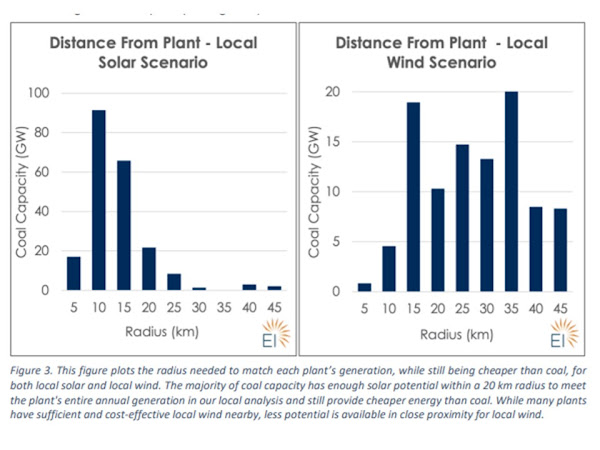Monday Study – New Energy With Storage Beats Coal In The Market
Coal Cost Crossover 3.0: Local Renewables Plus Storage Create New Opportunities for Customer Savings and Community Reinvestment
Michelle Solomon, Eric Gimon, Mike O’Boyle, Umed Paliwal, Amol Phadke, JANUARY 2023 (Energy Innovation)
Executive Summary
The cost of operating existing coal power plants in the United States continues to increase while coal jobs, generation, and mining all decrease. i New coal retirement announcements seem to happen faster, even as natural gas prices skyrocket, and renewable energy prices keep dropping.
The Inflation Reduction Act (IRA), which extended and expanded clean energy tax credits, along with new funding to guarantee loans for refinancing fossil assets and reinvesting in clean energy infrastructure, has shifted the economic scale even further toward wind and solar. But it also creates thoughtful new investment opportunities in areas burdened by existing coal plants with a 10 percent tax credit boost for projects located in nearby communities.
These factors underpin the third iteration of our Coal Cost Crossover analysis, which shows wind and solar energy are unequivocally cheaper than coal-fired generation across the country. This study finds 99 percent of all coal-fired power plants in the U.S. are more expensive to operate on a forward-looking basis than the all-in cost of replacement renewable energy projects, and 97 percent are more expensive than renewable energy projects sited within 45 kilometers (approximately 30 miles), a significant acceleration from our two previous analyses. For more than three quarters of U.S. coal capacity, the all-in cost per MWh of the cheapest renewable option is at least a third cheaper than the going-forward costs for the coal it would replace.
In this report we compare the cost of operating each continental U.S. coal plant in 2021, totaling 220 gigawatts (GW) of coal capacity across the country, to the estimated costs of building new wind and solar generation. We consider the wind and solar costs within two geographic scopes: local to the coal plants (within 45 kilometers) and regionally (roughly within the utility balancing area), finding that nearly all existing coal plants have multiple lowercost clean energy replacement options.
This research shows all but one of the country’s 210 coal plants are more expensive to operate than either new wind or new solar. If the IRA’s new energy community tax credit is included in the equation, 199 of the 210 plants are more expensive to operate compared to local solar resources sited within 45 kilometers of the plant. Local wind resources are also costeffective and readily available, with 104 plants having cheaper wind resources within 45 kilometers.
Altogether, 205 plants have local renewable options that would be cheaper than coal-fired electricity. This potential to replace existing coal plants with cheap, local clean energy generation creates significant economic benefits for community transition. Our analysis finds replacing these plants with local solar or wind would drive $589 billion in local capital investment that could support economic diversification, job creation, and tax revenue.
These local wind and solar resources could also help solve the problem of long interconnection queues—a significant barrier to renewables deployment. Renewable projects built near a retiring coal plant could use the existing plant’s interconnection, helping to further lower costs. If more policymakers consider this dynamic, they can streamline economic replacement and anticipate coal retirements, which are accelerating due to the cost dynamics analyzed in this report.
While solar and wind replacement resources provide significant low-cost energy and reliability value to the grid, savings generated by switching from more expensive coal to cheaper clean energy can finance other resources to provide additional energy and reliability value.
We find that the savings generated by shifting to local solar could fund the addition of 137 GW of four-hour batteries across all plants, and 80 percent or more of the capacity at a third of existing coal plants – the economics of replacing coal with renewables are so favorable that they could fund a massive battery storage buildout to add reliability value along with emissions reductions. However, it is important to remember reliability is a system attribute—replacement renewable portfolios need not bear sole responsibility for replacing the reliability services of individual coal plants.
While the economic case is clear and virtually universal, barriers remain to replacing coal with clean energy, and policymakers must act to unlock the cost savings and human health benefits for coal communities while reducing climate pollution.
Several policies can enable a faster coal-to-clean transition. Specifically:
▪ To prepare the way for coal transition, regulators and system operators should:
o Improve methods to assess reliability and resource adequacy reflecting the reliability value of renewable portfolios and valuing the reliability attributes of a high-renewables grid.
o Update interconnection study rules to leveraging existing coal plant interconnection rights to speed grid connection processes for local renewable replacement resources.
▪ To proactively pursue the transition, regulators should:
o Encourage utilities to utilize IRA financing programs available through the Departments of Energy and Agriculture to remove financial barriers to coal community economic transition and investment.
o Enable competitive resource procurement.
o Require re-assessment of any utility investment plan, including integrated resource plans and market-based solicitations for renewable supply, completed prior to IRA as renewables costs are now out of date.
▪ To create a just transition for affected communities, state legislatures and energy offices should:
o Plan for and fund a coal community-centered economic transition, where local clean energy resources are the anchor for a more expansive economic transition plan…


 click to enlarge
click to enlarge click to enlarge
click to enlarge click to enlarge
click to enlarge click to enlarge
click to enlarge click to enlarge
click to enlarge





0 Comments:
Post a Comment
<< Home